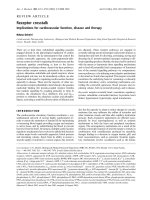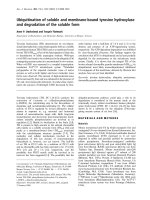Báo cáo y học: "Specific cyclooxygenase-2 inhibitors and aspirin-exacerbated respiratory disease" pptx
Bạn đang xem bản rút gọn của tài liệu. Xem và tải ngay bản đầy đủ của tài liệu tại đây (35.09 KB, 3 trang )
25
AERD = aspirin-exacerbated respiratory disease; COX = cyclooxygenase; cys-LT = cysteinyl leukotriene; LT = leukotriene; NSAIDs = non-steroidal
anti-inflammatory drugs; PG = prostaglandin.
Available online />Introduction
Up to 10–20% of the general asthmatic population have
hypersensitivity to aspirin and non-steroidal anti-inflamma-
tory drugs (NSAIDs) leading to severe exacerbation of
asthma and naso-ocular reactions [1,2]. Formerly termed
aspirin-sensitive asthma, these patients are now character-
ized as having aspirin-exacerbated respiratory disease
(AERD) because they have chronic upper and lower respi-
ratory-tract mucosal inflammation, sinusitis, nasal polypo-
sis, and asthma independent of their hypersensitivity
reactions [3]. Because essentially all traditional NSAIDs
also trigger the hypersensitivity reaction, treatment of pain
and inflammation has been challenging. With the introduc-
tion of drugs that specifically inhibit cyclooxygenase
(COX)-2, the question of whether these agents cross-
react with aspirin to cause exacerbation of asthma and
rhinitis becomes clinically relevant.
Eicosanoids are important mediators of bronchial reactiv-
ity and inflammation in asthma. In the asthmatic airway,
arachidonic acid is metabolized to prostaglandins (PGs)
and leukotrienes. PGE
2
functions as a bronchodilator and
can also inhibit granulocyte functions [4]. PGs are pro-
duced through an enzymatic pathway that includes the
COX enzymes. Both the COX-1 and COX-2 isoforms are
expressed in the respiratory epithelium (basal and ciliated
cells) in normal subjects and in patients with chronic
stable asthma and chronic bronchitis [5]. Epithelial
COX-1 expression is not different in asthmatics with or
without aspirin sensitivity and in normal subjects, whereas
COX-2 expression is increased in asthmatics compared
with normals but is not different in aspirin-sensitive asth-
matics compared with aspirin-tolerant asthmatics [4,6].
However, COX-2-expressing inflammatory cells are
increased in the submucosa of aspirin-sensitive asthmat-
Commentary
COX-2: where are we in 2003?
Specific cyclooxygenase-2 inhibitors and aspirin-exacerbated
respiratory disease
Leslie J Crofford
Associate Professor of Internal Medicine, Division of Rheumatology, University of Michigan, Ann Arbor, Michigan, USA
Corresponding author: Leslie J Crofford (e-mail: )
Received: 5 November 2002 Accepted: 19 November 2002 Published: 9 December 2002
Arthritis Res Ther 2003, 5:25-27 (DOI 10.1186/ar620)
© 2003 BioMed Central Ltd (Print ISSN 1478-6354; Online ISSN 1478-6362)
See related commentaries, pages 5, 8 and 28
Abstract
The use of analgesic anti-inflammatory agents in patients with asthma is clinically challenging because
of the prevalence (10–20%) of aspirin hypersensitivity. Aspirin-exacerbated respiratory disease
(AERD), or aspirin-induced asthma, is characterized by asthma and rhinitis triggered by the ingestion of
aspirin and non-steroidal anti-inflammatory drugs. AERD is associated with upper and lower
respiratory-tract mucosal inflammation, progressive sinusitis, nasal polyposis, and asthma regardless of
whether patients avoid triggering drugs. The mechanism underlying the propensity of aspirin and non-
steroidal anti-inflammatory drugs to cause this reaction is thought to involve inhibition of the synthesis
of protective prostaglandins (PGs), resulting in an increase in the synthesis of cysteinyl leukotrienes by
eosinophils and mast cells. Clinical data suggest that protective PGs are derived from cyclooxygenase
(COX)-1 because studies have now confirmed that drugs specifically inhibiting COX-2 are not cross-
reactive with aspirin in patients with AERD.
Keywords: aspirin, asthma, cyclooxygenase inhibitors, non-steroidal anti-inflammatory drugs
26
Arthritis Research and Therapy Vol 5 No 1 Crofford
ics [6]. Furthermore, COX-2 expression is increased in
airway epithelium in non-corticosteroid-treated asthmatics
compared with steroid-treated asthmatics and non-asth-
matic controls [7].
Although COX expression does not consistently distin-
guish aspirin-sensitive from aspirin-tolerant asthmatics, a
marked increase in expression of leukotriene C
4
(LTC
4
)
synthase in aspirin-sensitive asthmatics has been demon-
strated [4]. The cysteinyl leukotrienes (cys-LTs) are potent
bronchoconstrictors synthesized by the 5-lipoxygenase
and the LTC
4
synthase enzyme pathways of hematopoietic
cells [4]. In asthmatics with aspirin sensitivity there is a
large increase in cys-LT production after exposure aspirin,
and LT synthesis inhibitors and selective cys-LT receptor
antagonists markedly attenuate aspirin-induced respiratory
reactions [4]. This leads to the hypothesis that the aspirin-
and NSAID-mediated inhibition of PGE
2
production
releases a ‘brake’ on cys-LT synthesis by eosinophils and
mast cells, leading to marked overproduction that medi-
ates symptom exacerbation [4].
COX-2 inhibitors in asthma
The hypothesis that PGE
2
production in the setting of
AERD is derived from a COX-1-dependent pathway is
based chiefly on the clinical observation that selective
inhibitors of COX-2 have not been reported to cross-react
with aspirin in these patients. Initially, it was reported that
relatively selective COX-2 inhibitors such as nimesulide
and meloxicam had a reduced propensity to cross-react
with aspirin in patients with AERD, particularly at low
doses [3]. Several studies have now been reported to
determine rigorously whether the specific COX-2
inhibitors rofecoxib and celecoxib trigger asthma exacer-
bation or naso-ocular symptoms in patients with AERD
(Table 1) [3,8–10].
The most recent of these studies was reported by
Woessner et al. [3]. Sixty asthmatic patients with a
history of AERD completed a double-blind placebo-con-
trolled challenge with 100 and 200 mg of celecoxib over
2 days, followed by an aspirin challenge to confirm the
clinical history. All subjects exhibited adverse responses
to aspirin, but no subject developed either a significant
change in FEV
1
(forced expiratory volume in 1 s) or in the
naso-ocular symptom score. The confidence interval for
the probability of celecoxib inducing cross-reactions with
aspirin in AERD patients was calculated to be between
0% and 5%. All subjects had a very clear history of
AERD and demonstrated symptoms in response to
aspirin on the day after absence of response to cele-
coxib, demonstrating a lack of desensitization. All sub-
jects were allowed to remain on corticosteroids (nasal,
inhaled, and systemic) and leukotriene modifiers, elimi-
nating the confounder of withdrawing symptom-control-
ling medications.
Conclusions
Studies from several different laboratories have now con-
cluded that the specific COX-2 inhibitors rofecoxib and
celecoxib do not cross-react with aspirin and NSAIDs to
cause exacerbation of asthma or naso-ocular symptoms in
patients with AERD. These studies suggest that inhibition
of COX-1 is required to trigger the increased cys-LT pro-
duction associated with asthma exacerbation. However,
the mechanism by which COX-1, but not COX-2, inhibi-
tion might cause this response remains unclear. Although
these studies were performed as challenge tests rather
than as long-term placebo-controlled trials, they are con-
vincing. The fact that specific COX-2 inhibitors seem safe
in AERD does not imply that other hypersensitivity reac-
tions do not occur.
References
1. Szczeklik A, Nizankowska E, Duplaga M: Natural history of
aspirin-induced asthma. Eur Respir J 2000, 16:432-436.
2. Hedman J, Kaprio J, Poussa T, Nieminen MM: Prevalence of
asthma, aspirin intolerance, nasal polyposis and chronic
obstructive pulmonary disease in a population-based study.
Int J Epidemiol 1999, 28:717-722.
3. Woessner KM, Simon RA, Stevenson DD: The safety of cele-
coxib in patients with aspirin-sensitive asthma. Arthritis Rheum
2002, 46:2201-2206.
4. Cowburn AS, Sladek K, Soja J, Adamek L, Nizankowska E,
Szczeklik A, Lam BK, Penrose JR, Austen KF, Holgate SR,
Sampson AP: Overexpression of leukotriene C
4
synthase in
bronchial biopsies from patients with aspirin-intolerant
asthma. J Clin Invest 1998, 101:834-846.
5. Demoly P, Jaffuel D, Lequeux N, Weksler B, Creminon C, Michel
FB, Godard P, Bousquet J: Prostaglandin H synthase 1 and 2
immunoreactivities in the bronchial mucosa of asthmatics.
Am J Respir Crit Care Med 1997, 155:670-675.
6. Sousa AR, Pfister R, Christie PE, Lane SJ, Nasser SM, Schmitz-
Schumann M, Lee TH: Enhanced expression of cyclo-oxy-
genase isoenzyme 2 (COX-2) in asthmatic airways and its
cellular distribution in aspirin-sensitive asthma. Thorax 1997,
52:940-945.
7. Redington AE, Meng Q-H, Springall, D R, Evans TJ, Creminon C,
Maclouf J, Holgate ST, Howarth PH, Polak JM: Increased
expression of inducible nitric oxide synthase and cyclo-oxy-
genase-2 in the airway epithelium of asthmatic subjects and
regulation by corticosteroid treatment. Thorax 2001, 56:351-
356.
8. Szczeklik A, Nizankowska E, Bochenek G, Nagraba K, Mejza F,
Swierczynska M: Safety of a specific COX-2 inhibitor in aspirin-
induced asthma. Clin Exp Allergy 2000, 31:219-225.
Table 1
Specific COX-2 inhibitors in patients with aspirin-exacerbated
respiratory disorders (aspirin-induced asthma)
Study COX-2 Number Adverse Aspirin
inhibitor of patients reaction* response
Woessner et al. [3] Celecoxib 60 No Yes
Dahlen et al. [9] Celecoxib 27 No Not
tested
Szczeklik et al. [8] Rofecoxib 12 No Yes
Stevenson et al. [10] Rofecoxib 60 No Yes
* Decrease in FEV
1
(forced expiratory volume in 1 s) and/or induced
naso-ocular symptoms.
27
9. Dahlen B, Szczeklik A, Murray JJ: Celecoxib in patients with
asthma and aspirin intolerance. New Engl J Med 2001, 344:
142.
10. Stevenson DD, Simon RA: Lack of cross-reactivity between
rofecoxib and aspirin in aspirin-sensitive patients with
asthma. J Allergy Clin Immunol 2001, 108:47-51.
Correspondence
Leslie J Crofford, MD, Room 5510E, MSRB-I, 1150 W. Medical Center
Drive, Ann Arbor, MI 48109-0680, USA. Tel: +1 734 936 3257; fax:
+1 734 763 2025; e-mail:
Available online />









